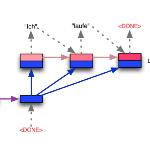Information extraction and user intention identification are central topics in modern query understanding and recommendation systems. In this paper, we propose DeepProbe, a generic information-directed interaction framework which is built around an attention-based sequence to sequence (seq2seq) recurrent neural network. DeepProbe can rephrase, evaluate, and even actively ask questions, leveraging the generative ability and likelihood estimation made possible by seq2seq models. DeepProbe makes decisions based on a derived uncertainty (entropy) measure conditioned on user inputs, possibly with multiple rounds of interactions. Three applications, namely a rewritter, a relevance scorer and a chatbot for ad recommendation, were built around DeepProbe, with the first two serving as precursory building blocks for the third. We first use the seq2seq model in DeepProbe to rewrite a user query into one of standard query form, which is submitted to an ordinary recommendation system. Secondly, we evaluate DeepProbe's seq2seq model-based relevance scoring. Finally, we build a chatbot prototype capable of making active user interactions, which can ask questions that maximize information gain, allowing for a more efficient user intention idenfication process. We evaluate first two applications by 1) comparing with baselines by BLEU and AUC, and 2) human judge evaluation. Both demonstrate significant improvements compared with current state-of-the-art systems, proving their values as useful tools on their own, and at the same time laying a good foundation for the ongoing chatbot application.
翻译:信息提取和用户意向识别是现代查询理解和建议系统的核心议题。 在本文中,我们提出DeepProbe(DeepProbe),这是一个通用的信息导向互动框架,围绕一个关注的序列,围绕一个基于关注的序列,构建了常规神经网络(seq2seq)的常规神经网络。DeepProbe可以重拟、评估甚至积极提问,利用后继2seq模型提供的基因变异能力和可能性估算。深Probe根据基于用户投入的衍生不确定性(元素性)测量方法,并可能进行多轮互动,做出决策。最后,我们在DeepProbe周围建立了三个应用程序,即重写者、相关性计分器和供推荐之用的聊天器。前两个应用程序是第三个的先行构件。我们首先使用DeepProbe的后继2eqeq模型将用户查询改写成标准查询表之一,该表提交给一个普通建议系统。 其次,我们评估DeeproProbe的后继2seqeque 模型的实用性评分值。最后,我们建立一个可进行积极的用户互动互动的原型模型,先问问题,然后比较当前应用程序的进度,然后比较当前的用户基准。我们用新的基准2),通过测试,用一个高效评估工具,然后测试。我们用一个有效的用户基准,用新的工具来比较当前的评估。





